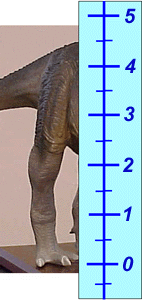| We wish to know
the height of the model at the hips. Standing 2m away from it, with plastic ruler held at
arm's length, produces the view seen at the right. The blue plastic ruler can be seen
vertically superimposed on the tyrannosaur model so that the height of the model at the hips
can be readily evaluated. We see that at this position, the base of the foot is at the "0"
division of the ruler and the upper surface of the body is at the "4 and 1/2" mark on the
ruler. Thus, the model extends 4 and 1/2 major divisions of the hand held ruler. Since we
have already established in Step 2 that at a target distance of 2m, each major division
on the ruler is equivalent to 10 cm of actual distance on the target object - the
tyrannosaur model in this case - we can calculate the height of the model as:
MODEL HEIGHT
= (4.5 divisions) x (10cm/division) = 45 cm
This example illustrates the general rule that:
Actual distance =
(No. of ruler divisions) x (distance for 1 ruler division)
Remember that this relation is only correct when the target distance is equal to the
distance at which you calibrated your hand-held plastic ruler (2m in the example described
here). |
 |







